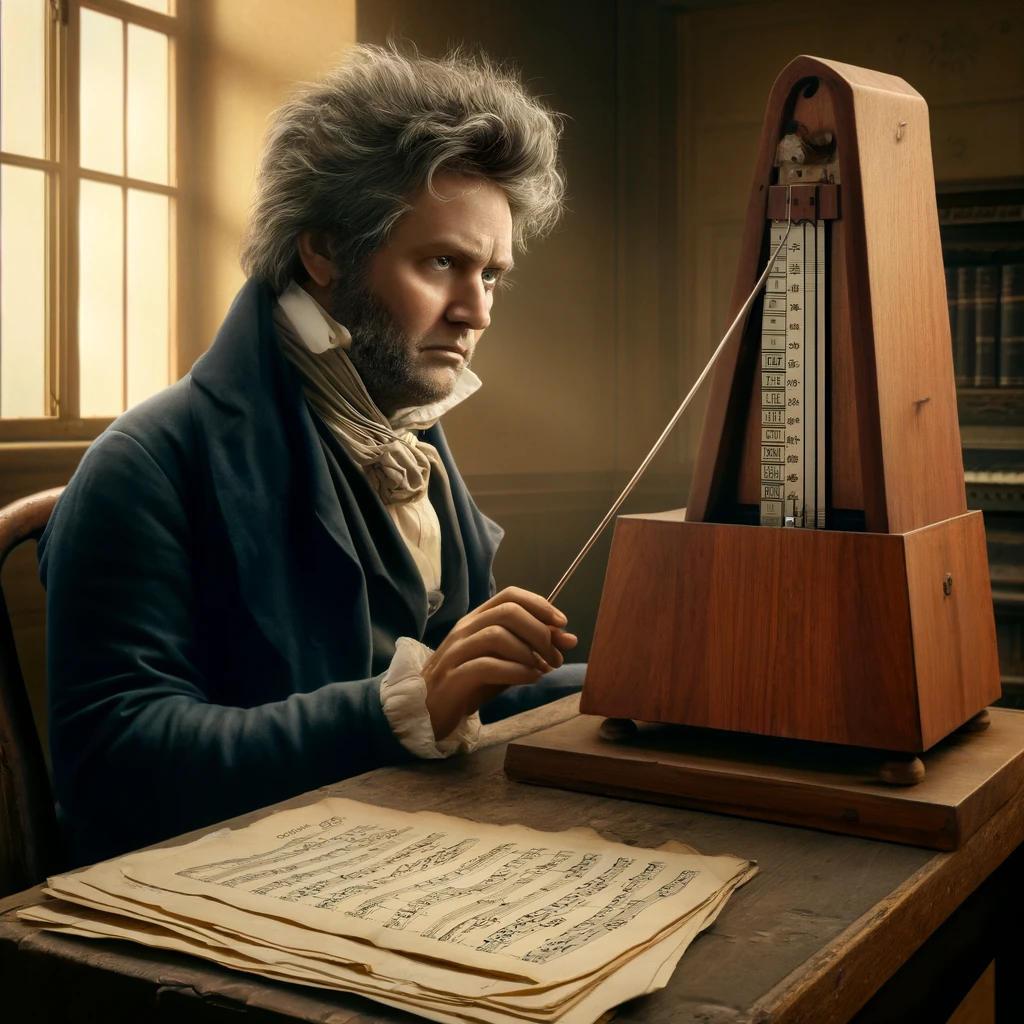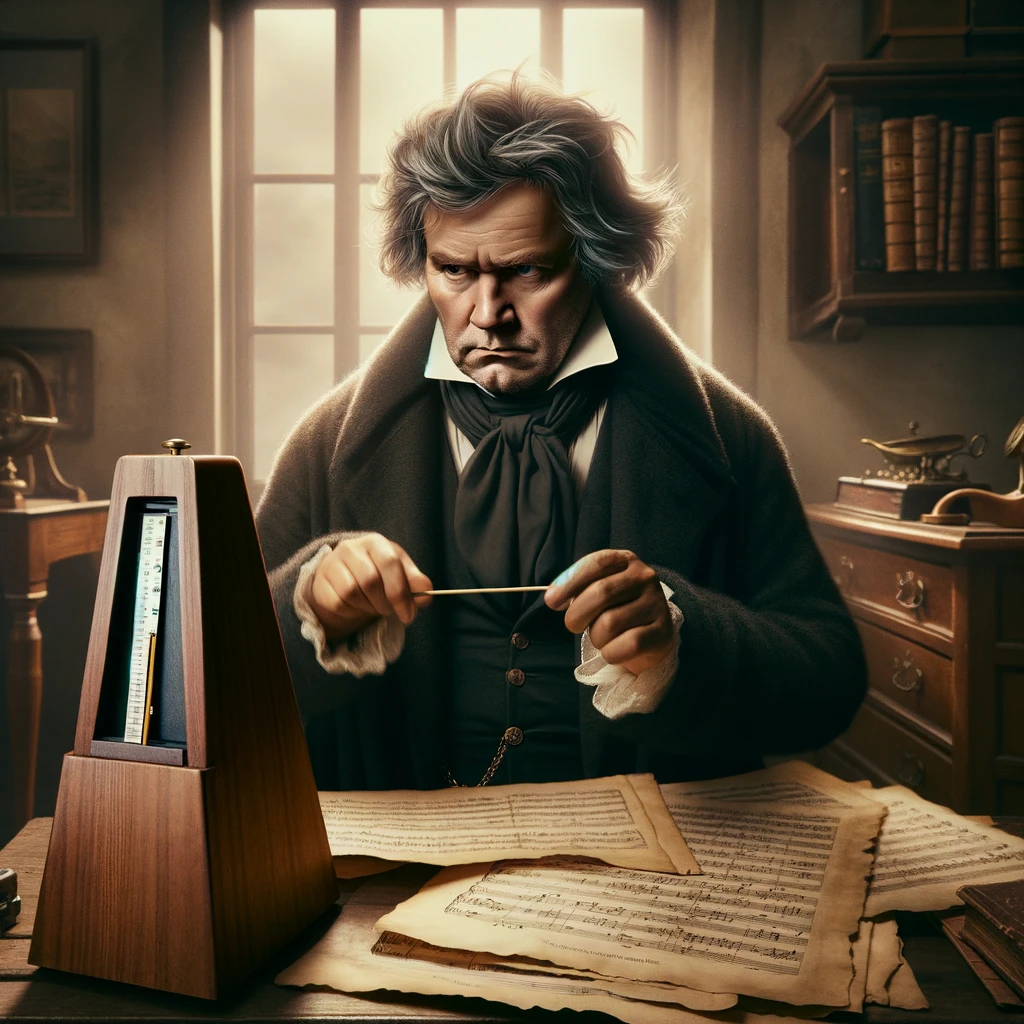
Beethoven and the Metronome: Discovering Tempo
Ludwig van Beethoven, a towering figure in the world of classical music, is often remembered for his symphonies and sonatas. However, a lesser-known aspect of his legacy is his relationship with the metronome, an instrument that profoundly influenced how he intended his compositions to be played.
The Birth of the Metronome
The metronome was developed by Johann Nepomuk Mälzel in 1815, and it soon caught Beethoven’s interest. Before the invention of the metronome, musical tempos were indicated by vague terms like “allegro” or “presto,” which could be interpreted differently by various conductors. The introduction of the metronome provided a means to precisely dictate the speed of a piece.
Beethoven was among the first composers to adopt this new device. He saw its potential to convey his musical vision more accurately to performers and audiences alike. This was crucial for Beethoven, especially as he began to lose his hearing and relied more on exact musical expressions that could be universally understood.
Beethoven’s Adoption of Metronome Markings
Starting with his Eighth Symphony, Beethoven began revising his earlier compositions to include metronome markings. This was a meticulous process, as he had to reconsider each piece’s tempo to best reflect his original intent. For example, his famous Symphony No. 5, originally noted just with the term “allegro,” was later specified with a metronome marking of 108 beats per minute for the opening movement. This precise tempo setting helped ensure that the urgency and intensity he envisioned were effectively communicated.
Beethoven’s use of the metronome was not without controversy. Some contemporaries and later musicians argued that his markings were too rigid, potentially stifling the expressive freedom of performers. Despite these criticisms, Beethoven’s metronome markings provided a window into his creative mind, offering clues about the emotional landscapes he aimed to construct with his music.
The Metronome and Beethoven’s Deafness
As Beethoven’s hearing deteriorated, the metronome became even more significant in his life. It allowed him to compose with an assurance that the temporal aspects of his music would be preserved. Interestingly, some scholars suggest that the metronome’s ticking may have been one of the few sounds Beethoven could perceive as his hearing waned, making it a crucial link between his musical ideas and the reality of performance.
The metronome also played a symbolic role during this period of his life. It represented Beethoven’s struggle and determination to continue composing despite his disability. It was a tool that helped him bridge the gap between silence and sound, ensuring that his musical voice could still be heard as he intended.
Beyond Beethoven: The Metronome’s Legacy
The implications of Beethoven’s use of the metronome reached far beyond his own compositions. It set a precedent for other composers to consider how tempo could be used to enhance musical expression systematically. The metronome’s ability to standardize tempo across performances meant that works could be more consistently interpreted according to the composer’s specifications, a practice that has become standard in classical music performance today.
Moreover, Beethoven’s meticulous approach to tempo demonstrated his revolutionary vision for music as a structured yet deeply emotional art form. His legacy in this area encourages musicians and composers to think critically about the role of tempo in shaping a musical narrative, ensuring that each note and rest serves the greater emotional and structural goals of the piece.
Ludwig van Beethoven’s engagement with the metronome was more than just a technical novelty—it was a profound expansion of the composer’s toolkit, enhancing musical precision and expressiveness. As we continue to explore and perform Beethoven’s works, the metronome remains a vital tool, not only for maintaining the integrity of his compositions but also for understanding the meticulous care with which he crafted his musical legacy.
The story of Beethoven and the metronome is a testament to the enduring power of innovation in art. It reminds us that even well-established creative practices can benefit from new technologies, and that these tools can profoundly affect how art is made, experienced, and remembered.

Exploring the Personal Impact of the Metronome on Beethoven’s Compositions
Beethoven’s embrace of the metronome also had a personal dimension, reflecting his innermost musical sensibilities and his adaptive strategies in the face of increasing deafness. His precise tempo markings were not merely technical instructions; they were expressions of his emotional intent. By meticulously determining the pace of each piece, Beethoven could ensure that the dramatic contrasts and emotional depth of his music were faithfully rendered, regardless of his ability to hear them performed.
Sonata Op. 106 “Hammerklavier”
A standout example of Beethoven’s use of the metronome is found in his “Hammerklavier” Sonata, Op. 106. This sonata is renowned for its technical difficulty and emotional range. Beethoven’s specified metronome marking for the opening movement is unusually fast, challenging even the most skilled pianists. This marking has sparked debate among musicians and scholars: some see it as a test of technical prowess, while others view it as an expression of the tumultuous emotions Beethoven was grappling with at the time.
The “Hammerklavier” was composed during a period of profound personal crisis and isolation, exacerbated by Beethoven’s nearly complete deafness. By setting such demanding tempo requirements, Beethoven was not only pushing the boundaries of piano performance but also communicating the intensity of his personal struggles through music. The metronome provided a way to ensure that performers could grasp and convey this intensity, even if they could not directly relate to the depth of its creator’s despair.
The Ninth Symphony
Beethoven’s Ninth Symphony, one of his last major works, also showcases the critical role of the metronome in his compositions. The symphony’s final movement, which includes the famous “Ode to Joy,” is marked with specific tempos that guide the transition from the dramatic, urgent choral entry to the jubilant finale. Here, Beethoven’s tempo markings serve a crucial narrative function, directing the musical flow in a way that enhances the thematic progression from darkness to light, despair to joy.
This masterful control of tempo helps create a powerful, unified experience, ensuring that the symphony’s complex layers of meaning are accessible to all listeners. The precision of the metronome markings ensures that each performance can attempt to recapture Beethoven’s visionary scope, maintaining the work’s emotional and philosophical richness across different interpretations and settings.
The Metronome and Modern Performances
The influence of Beethoven’s metronome markings extends into modern classical music performance. Today, conductors and soloists often grapple with the decision of whether to adhere strictly to Beethoven’s indicated tempos. Some modern interpreters argue that a flexible approach to tempo allows for a more nuanced expression suited to contemporary sensibilities and acoustic environments. Others, however, advocate for a strict adherence to Beethoven’s specifications, viewing them as an essential component of his musical expression.
This debate highlights the ongoing relevance of Beethoven’s work in the classical music community. It raises important questions about the balance between historical fidelity and modern interpretation, a dialogue that is central to the performance of all classical music.
Conclusion
Ludwig van Beethoven’s relationship with the metronome was transformative, not only for his compositions but for the realm of music at large. It enabled him to compose with unprecedented precision, helping to shape the emotional and structural aspects of his music in ways that were previously unachievable. For Beethoven, the metronome was not just a tool for ensuring tempo accuracy; it was an instrument through which he could sculpt time itself, crafting lasting expressions of human emotion and experience.
Beethoven’s innovative use of the metronome remains a testament to his genius and his determination to connect with audiences in the most profound ways possible. As we continue to explore and interpret his works, the insights provided by his tempo markings offer a deeper understanding of his music and its timeless appeal.